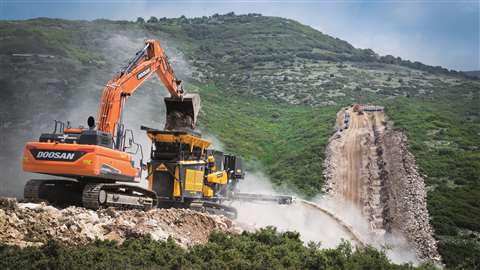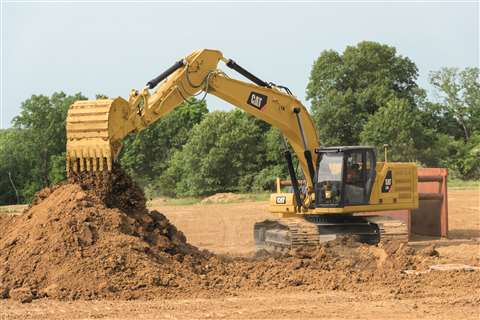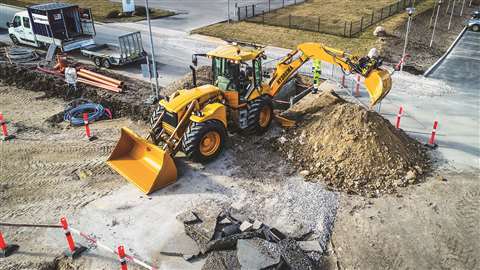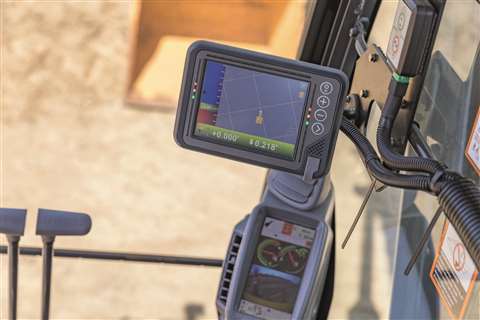The future of earthmoving equipment
19 November 2018
Earthmoving equipment is a staple of the construction industry, with a whole host of different machinery being used on earthmoving projects. This feature focuses specifically on excavators, rollers, backhoe loaders and the machine control used on these machines.

The world’s biggest original equipment manufacturer for the construction industry by sales revenue, Caterpillar, has recently launched two new 30 ton (27.2 tonne) next generation excavators – the 330 and 330 GC.
The new Cat 330 features standard integrated Cat Connect technology and has the most power and lift capacity of the two models. It was also said by the company to have the industry’s highest level of standard factory-equipped technology to boost productivity. The 330 GC combines a balance of productivity features with reduced fuel consumption and maintenance costs.
The standard Cat Grade with 2D system provides guidance for depth, slope and horizontal distance to grade through the standard touchscreen monitor, making operators more accurate, and the system is readily upgradable. Standard Grade Assist automates boom, stick, and bucket movements so operators can stay on grade with single-lever digging.
“The new Cat 330 and 336 Next Generation excavators benefit from the same technological advancements as the 320 and 323 Next Generation excavators we announced at the end of last year. The Grade, Payload and Assist functions help deliver up to 45% more operator efficiency,” said Laurent Sarignac, excavator product marketing specialist for Africa and the Middle East at Caterpillar.

More new launches
Another new excavator product launch has recently been announced, this time by Liebherr. From January 2019, the company will launch ‘Generation 8’ crawler excavators. For the initial launch period, the Generation 8 includes six models: the R 922, R 924, R 926, R 930, R 934 and R 938. The R 922 and R 924 are available for higher-regulated countries, whereas the four other models are available for higher- and lower-regulated countries with the relevant engines. The excavators will have an operating weight of between 22 and 45 tonnes.
At a Liebherr event in Canada, Martin Schickel, managing director of sales, Liebherr-France SAS, said, “A new equipment concept with a hollow molded piece at the top of the boom is one of the innovative features of our new excavator generation. This leads to better performance and equipment forces with reduced operating weight of the machine.
“An additional novelty is the optimised load curve, which yields reduced fuel consumption. For the maintenance-free travel gear and track rollers on the undercarriage, the reliability has also been significantly enhanced by applying a lifetime lubrication concept.”
At the start of the year, Hyundai launched the HX130 LCR, the third compact-radius excavator model in the company’s HX series product line. The 13 ton (11.7 tonne) machine is also available in a second standard configuration, the HX130 LCRD, which includes a dozer blade. The new machine is the 15th HX series excavator model.
The company said that the HX130 LCR fills an important spot in its excavator lineup. The market demand was said to be growing for this weight class, especially for compact-swing machines that give contractors the added versatility of working in confined spaces.
Earthmoving equipment is being used on projects all around the world, such as LiuGong excavators in Myanmar (Burma) in Asia. During the rainy season in Myanmar, heavy rains last for long periods. This may adversely affect many projects and at the same time impose high requirements on engineering equipment.
In the Yangon River a LiuGong 925E excavator is shovelling river sand from a large cargo ship to trucks. The sand is collected from the Yangon River and then transported to various construction sites.
According to Wu Aung Thet Tun, the owner of the sand workshop, the LiuGong 925E excavator has become his main labour force, loading 120 trucks per day, with each truck containing 12 tonnes of sand.
“We have been using LiuGong equipment for five years. They are highly efficient while the fuel consumption is low,” said Wu Aung Thet Tun.
Backhoe loaders

It is not just excavators that are seeing new product launches, with Denmark-based Hydrema launching a new generation of backhoe loaders. The company claims that the machines are much more than just backhoe loaders, with R&D manager Thorkil K Iversen, saying, “Hydrema’s backhoe loaders are fully-fledged excavators and wheel loaders combined. Hydrema backoe loaders have articulated steering, which effective wheel loaders must have.”
The new F-series machines, 906, 908, 926 and 928 models have been fitted with Cummins engines updated to Stage IV. At the same time, the smaller models 906F and 908F have an increased engine power of 12hp, so they now reach 122hp. The larger models 926F and 928F have a changed power bulge, which was said to ensure more power and better torque at reduced engine revolutions.
The new F-series machines have a fully redesigned front-chassis, which optimises the operator’s visibility from the cab. This provides a better view of the front shovel and down the side of the engine bonnet when mounting attachments.
Komatsu Europe announced the launch of a new range of backhoe loaders in line with EU Stage IV emissions regulations earlier this year at Intermat, Paris, France. Released for sale in September 2018 is the WB93R, with a second new backhoe loader planned to be introduced shortly afterwards. Based on the current machines, these improved EU Stage IV models were said to provide improvements in efficiency and reduced fuel consumption.
“This new series represents a perfect match between performance and efficiency,” said Alex Visentin, product manager at Komatsu Europe. “Keeping the exceptional visibility and exclusive design for the work equipment of previous models, our new backhoe loaders deliver high productivity and give special attention to the operator’s needs.”
Intelligent machine control
Earlier this year Volvo Construction Equipment (Volvo CE) expanded its range of intelligent machine control systems. The company has introduced a full suite of Volvo Assist programmes to the European market, which incorporates the upgraded Load Assist for wheeled loaders, Haul Assist for articulated haulers, Dig Assist for excavators, Compact Assist for soil and asphalt compactors, and Pave Assist for asphalt pavers.
All Volvo Assist programs are powered by the recently updated Volvo Co-Pilot on-board display, designed to boost profitability through greater task accuracy. The 25cm touchscreen is an intuitive, scalable platform that uses on-board machine data and high precision sensors to deliver real-time data, for what was said to be greater operator efficiency and site performance.
Each Volvo Assist platform features an intuitive set of productivity-enhancing applications that help the operator monitor the progress and output of their work in real-time.
Another OEM offering machine control options is John Deere, with its G-Series motor grader line.

SmartGrade technology delivers mastless Topcon 3D integrated grade control as a factory option on new machines and field kit for equipment already on the job. The system is incorporated into the machine’s structures and software, delivering precise grading performance while eliminating vulnerable masts and cables.
“Earthmoving customers already utilise SmartGrade technology integrated into Deere dozers, and many have asked when it would be available on the motor grader line,” said Luke Kurth, motor graders product marketing manager, at John Deere Construction & Forestry.
“We’re excited to be the first manufacturer to offer this integrated solution to the industry,” he said.
Doosan’s own telematics system was recently extended to cover 60,000 of the company’s excavators, wheeled loaders and articulated dump trucks (ADTs) worldwide. While machine control is important, it is also essential that earthmoving equipment can operate in different conditions around the world.
Stephane Dieu, product and sales trainer at Doosan, said, “Equipment for earthmoving projects needs to offer reliability, availability and low cost of ownership, on all types of contracts all around the world, with very different climate conditions.
“Doosan excavators are designed for work anywhere in the world: One of the Russian contractors who worked on the construction work for the Sochi Winter Olympics said that in the very low temperatures during work on the site in winter time, the only machines that carried on working on site were the Doosan excavators. In Saudi Arabia, in the opposite type of conditions, Doosan is a market leader in excavators, again due to the high reliability of the machines, even in weather that is the worst possible for mechanical systems.”






